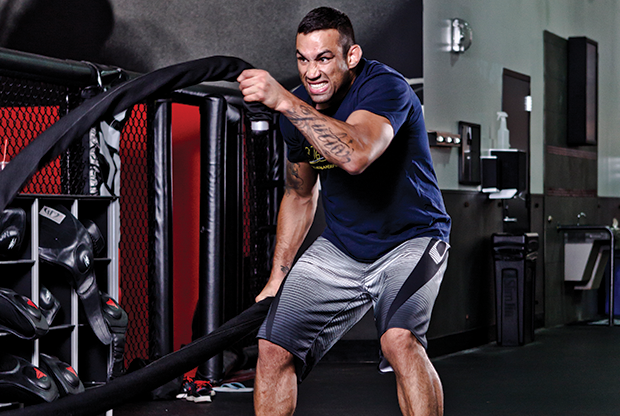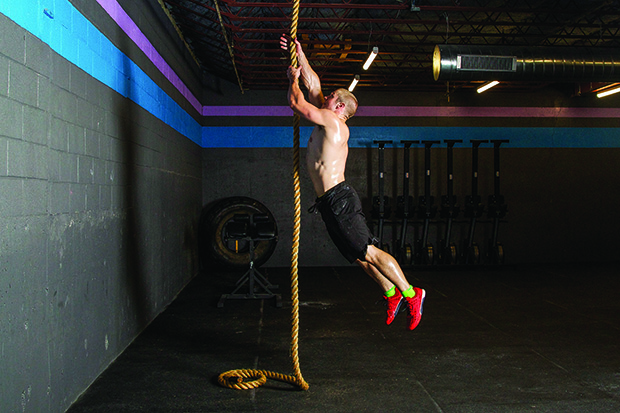


Utilize this dynamic training tool for upper-body muscle and power.
I had a client once who got upset that the gym I was working for invested money in some heavy-gauge ropes instead of more machines. Although I disagreed, I understood his argument. How could these ropes contribute toward building a shredded physique? During our next workout, we finished with some rope exercises and that was the last time I ever heard him complain about the usefulness of ropes.
Rope training was originally made popular by the military. Soldiers and sailors are known for being in top physical shape, and most branches of service require their enlistees to successfully climb a rope. Being able to pull yourself up is a phenomenal physical trait to have. Although most people don’t and shouldn’t train with the same intensity and frequency as the military, the experience and availability of rope climbing should be enticing to most.
John Brookfield, the creator of the original Battling Ropes System, decided to use the implements a different way. He discovered a great metabolic workout by anchoring the rope down to an immovable object (often a heavy kettlebell) and manipulating the opposite ends of the ropes. This produced workouts that stimulated muscles in the arms, shoulders, and core while it promoted fat loss and conditioning.
Rope Climbing
I’ve personally worked with women who struggle with doing a pull-up but are able to climb a rope when taught correctly. Climbing a rope targets your grip strength, forearms, biceps, shoulders, core, and legs. Unlike lat pull-downs or leg curls, the ability to pull yourself up is a valuable skill that can improve your chance of survival in a disaster. Here are a few techniques of rope climbing that can be used:
The Gym Class: Back when physical education was actually taught in PE class, students performed activities that challenged their fitness. The gym-class technique is what people usually do when they haven’t been taught how to climb properly. They jump up, grab on the rope, and allow the rope to fall between their feet. Then they attempt to pinch the rope between their legs to help propel them upward. Unfortunately this doesn’t afford you much leverage. This technique is manageable if you have enough upper-body strength, but you can quickly burn out if you need to perform multiple climbs.
The Twist and Lock: The prerequisite for this technique is being able to hold your body up with your knees to your chest for five to 10 seconds. If you can do this, then you should have the necessary strength to proceed. This technique is the most popular one because when done properly, your legs do most of the work. All you need to do is first jump and grasp the rope as high as you can. With your knees bent toward your chest and rope between your legs, twist the rope around your dominant leg counterclockwise and allow the rope to lie on top of your foot. Then take your other foot and place it on top of the rope that is lying on your dominant foot. Straighten your legs to move up the rope and bring your torso close to your hands. Grab the rope as high as you can again, loosening up your legs to allow your hips and knees to flex, re-adjusting your twist-and-lock technique. This repeated process will allow you to climb the rope with no issue. When first learning this technique, I suggest having someone hold the rope at the bottom to prevent it from swaying. Once you understand how to repeatedly re-adjust your twist-and-lock technique, you can do it without anyone holding the other end.

The Clamp: This technique is similar to the twist-and-lock technique and allows you to get up and down the rope quicker if you master the technique. Like the twist and lock, jump up and grab the rope as high as you can. Let the rope fall to the outside of your right leg. Step on the rope with your right foot by bringing it up with your left foot. The combination of the rope running underneath your right foot and on top of your left foot will lock the rope in place. Bring your knees into your chest, clam the rope between your feet, and extend your knees and hips. Once your legs are extended, grasp the rope as high as you can again and repeat the process.
More advanced techniques such as the no-leg (using only your arms) or the L-sit (keeping your legs in a pike position) require extreme upper-body strength and should only be reserved for those who are able to safely pull themselves up and lower themselves down.
Battle Ropes
Depending on their variation, battle-rope combinations can be targeted or work your entire body all at once. I train my athletes in different planes of motion: sagittal (right/left), frontal (front/back), and transverse (rotational). This teaches them to be able to move in different directions with force and power. This should also be incorporated for everyone, not only to prevent injuries and muscle imbalances but to offer different challenges for well-rounded power and fitness. They are also a good way to break up any training monotony that has set in. Check out a few of my favorite battle-rope exercises:
Double Wave: The double wave is the easiest variation to master, but very effective. Hold one end of the rope in each hand with your feet shoulder-width apart. Stand in an athletic position with your hips back and chest up. Brace your abs and move the ropes up and down, creating a wave-like motion. As the ropes go up, extend your hips by driving through your legs and as the ropes come back down, re-bend your hips and knees.
Alternating Wave: These are done the same way as the double wave except you alternate between your right and left arms. This is more intense and demands greater coordination, especially as fatigue sets in.
Rotational Uppercuts: Popularized by MMA fighters, this trains athletes in the transverse plane, which is crucial for high performance. Grasp the rope with your thumbs pointing up as if you were to throw a punch. The handles of the rope should also be pointed upward. Rotate your hips and throw alternating uppercut punches. Similar to the other movements, keep your abs braced and start in an athletic position. As you become more comfortable with the continuous motion, bend and move your upper body in a “bob and weave” motion similar to a boxer. This is a great conditioning exercise since the rope is weighted and you are moving your body in a rotational manner, which heightens the intensity.
By Cornell Hunt, CSCS






















You must be logged in to post a comment Login